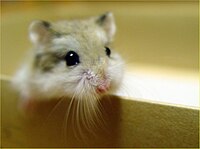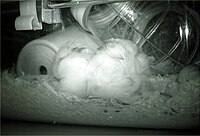Difference between revisions of "AY Honors/Small Mammal Pets/Answer Key"
(Correction) |
|||
| Line 1: | Line 1: | ||
| − | [[ | + | {{Taxobox |
| + | | color = pink | ||
| + | | name = Roborovski Hamster | ||
| + | | image = Roborovski Dwarf Hamster - Colour Corrected.jpg | ||
| + | | image_width = 220px | ||
| + | | regnum = [[Animal]]ia | ||
| + | | phylum = [[Chordata]] | ||
| + | | classis = [[Mammal]]ia | ||
| + | | ordo = [[Rodent]]ia | ||
| + | | familia = [[Cricetidae]] | ||
| + | | subfamilia = [[Cricetinae]] | ||
| + | | genus = ''[[Phodopus]]'' | ||
| + | | species = '''''P. roborovski''''' | ||
| + | | binomial = ''Phodopus roborovski'' | ||
| + | | binomial_authority = ([[K. A Satunin|Satunin]], 1903) | ||
| + | }} | ||
| − | ''' | + | '''Roborovskis''' ('''''Phodopus roborovski''''') are the smallest and fastest of all [[hamster]]s and are commonly kept as [[pet]]s. Distinguishing characteristics of the Roborovskis are the white spots where their eyebrows would be, and the lack of a dorsal stripe commonly seen in dwarf hamsters. They live, on average, to three and a half years of age - the longest of any domestic hamster. |
| − | + | They are very curious, however easily startled and generally quite shy. They are social and when socialised from an early age, sleep together in one place. Their speed makes them generally unsuitable for children who wish to have a pet they can hold and play. They are very affectionate when introduced at a young age. They do have very good tempermant and rarely bite. As they grow to be roughly the size of an adult's thumb, they can easily squeeze through the bars of a standard hamster cage, and so careful consideration needs to be given to housing. Always ask pet shop owners or breeders what is the best ideal cage to use. Because of their size and speed, Roborovskis are best for people who prefer to observe rather than to play with their pet. | |
| − | |||
| − | + | {| | |
| − | [[ | + | |- |
| − | + | | [[image:Roborovski Face.jpg|none|thumb|200px|Roborovskis' facial markings differ from those of other hamsters.]] | |
| + | | [[image:Roborovskis Sleeping Together.jpg|none|thumb|200px|Roborovskis are extremely social and like to sleep together.]] | ||
| + | |} | ||
| − | + | Because of their size and features, they can be comical pets when observed in social groups. If kept together in mixed sex pairs or groups Roborovski Hamsters usually start to breed in the spring following the year in which the female was born. Females often become sterile at around 24 months of age but males usually remain fertile for most of their life. | |
| − | |||
| − | + | Roborovski hamsters gestate for around 23-30 days. When the young are born they resemble pink beans. At around 5-6 days the skin may start to pigment and at 6-8 days hair begins to emerge. By 10-12 days the babies are covered in short fur and the eyelids are beginning to mature. At this time the babies may also start wandering around the cage, even though still blind. The female will usually collect the wandering babies and return them to the nest - this may be accompanied by squealing from the babies but is not usually anything to worry about. At 14-16 days of age the eyes open and the babies are fully covered in fur. The babies are fully weaned and can be removed from the mother at 4 weeks of age. | |
| − | |||
| − | |||
| − | |||
| − | |||
| − | |||
| − | |||
| − | |||
| − | |||
| − | |||
| − | |||
| − | |||
| − | |||
| − | |||
| − | |||
| − | |||
| − | |||
| − | |||
| − | |||
| − | |||
| − | |||
| − | |||
==External links== | ==External links== | ||
| − | *[http://www. | + | *[http://www.petwebsite.com/hamsters/roborovski_hamsters.htm Pet Web Site (formerly The Complete Hamster Site) section on Roborovski Hamsters] |
| − | + | *[http://www.hamster-heaven.com Hamster Heaven] | |
| − | + | *[http://roborovski.tk/ R&R Hamsters (a.k.a. Roborovski Hideout)] | |
| − | * | ||
| − | |||
| − | *[http:// | ||
| − | |||
| − | |||
| − | |||
| − | |||
| − | |||
| − | [[Category: | + | [[Category:Hamsters]] |
| + | [[Category:Mammals of Asia]] | ||
| − | [[de: | + | [[de:Roborowski-Zwerghamster]] |
| + | [[fr:Hamster de Roborovski]] | ||
| + | [[it:Phodopus roborovskii]] | ||
| + | [[ja:ロボロフスキーハムスター]] | ||
| + | [[pl:Chomik Roborowskiego]] | ||
| + | [[pt:Hamster Roborovski]] | ||
| + | [[fi:Roborovskinkääpiöhamsteri]] | ||
| + | [[zh:沙漠侏儒倉鼠]] | ||
Revision as of 01:09, 16 February 2007
Roborovskis (Phodopus roborovski) are the smallest and fastest of all hamsters and are commonly kept as pets. Distinguishing characteristics of the Roborovskis are the white spots where their eyebrows would be, and the lack of a dorsal stripe commonly seen in dwarf hamsters. They live, on average, to three and a half years of age - the longest of any domestic hamster.
They are very curious, however easily startled and generally quite shy. They are social and when socialised from an early age, sleep together in one place. Their speed makes them generally unsuitable for children who wish to have a pet they can hold and play. They are very affectionate when introduced at a young age. They do have very good tempermant and rarely bite. As they grow to be roughly the size of an adult's thumb, they can easily squeeze through the bars of a standard hamster cage, and so careful consideration needs to be given to housing. Always ask pet shop owners or breeders what is the best ideal cage to use. Because of their size and speed, Roborovskis are best for people who prefer to observe rather than to play with their pet.
Because of their size and features, they can be comical pets when observed in social groups. If kept together in mixed sex pairs or groups Roborovski Hamsters usually start to breed in the spring following the year in which the female was born. Females often become sterile at around 24 months of age but males usually remain fertile for most of their life.
Roborovski hamsters gestate for around 23-30 days. When the young are born they resemble pink beans. At around 5-6 days the skin may start to pigment and at 6-8 days hair begins to emerge. By 10-12 days the babies are covered in short fur and the eyelids are beginning to mature. At this time the babies may also start wandering around the cage, even though still blind. The female will usually collect the wandering babies and return them to the nest - this may be accompanied by squealing from the babies but is not usually anything to worry about. At 14-16 days of age the eyes open and the babies are fully covered in fur. The babies are fully weaned and can be removed from the mother at 4 weeks of age.
External links
- Pet Web Site (formerly The Complete Hamster Site) section on Roborovski Hamsters
- Hamster Heaven
- R&R Hamsters (a.k.a. Roborovski Hideout)
de:Roborowski-Zwerghamster fr:Hamster de Roborovski it:Phodopus roborovskii ja:ロボロフスキーハムスター pl:Chomik Roborowskiego pt:Hamster Roborovski fi:Roborovskinkääpiöhamsteri zh:沙漠侏儒倉鼠


